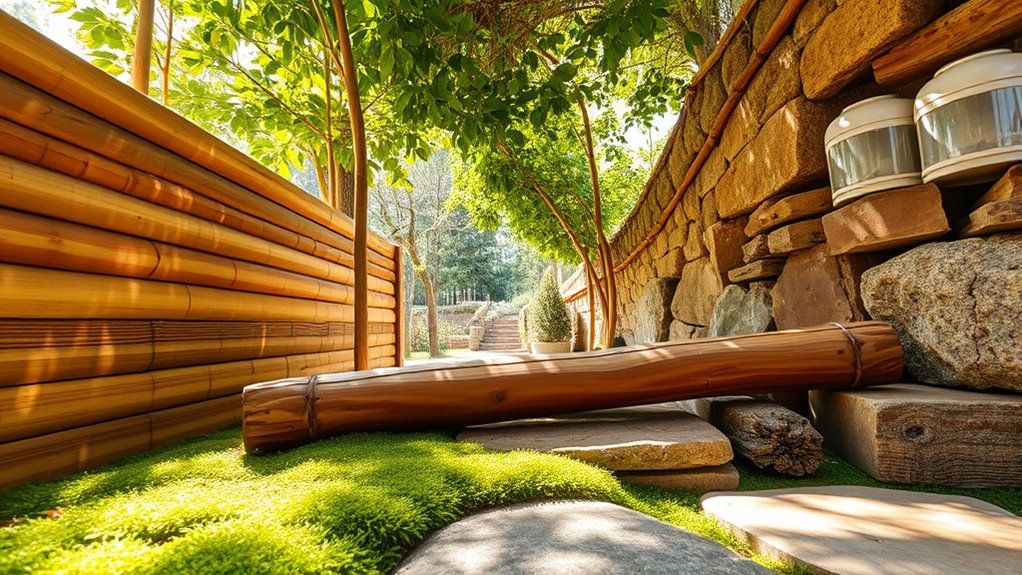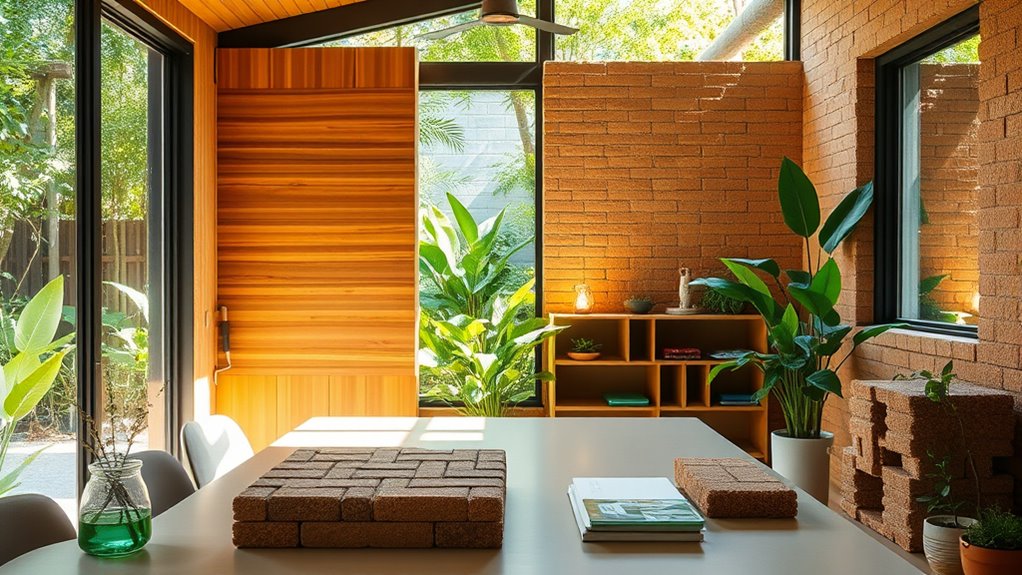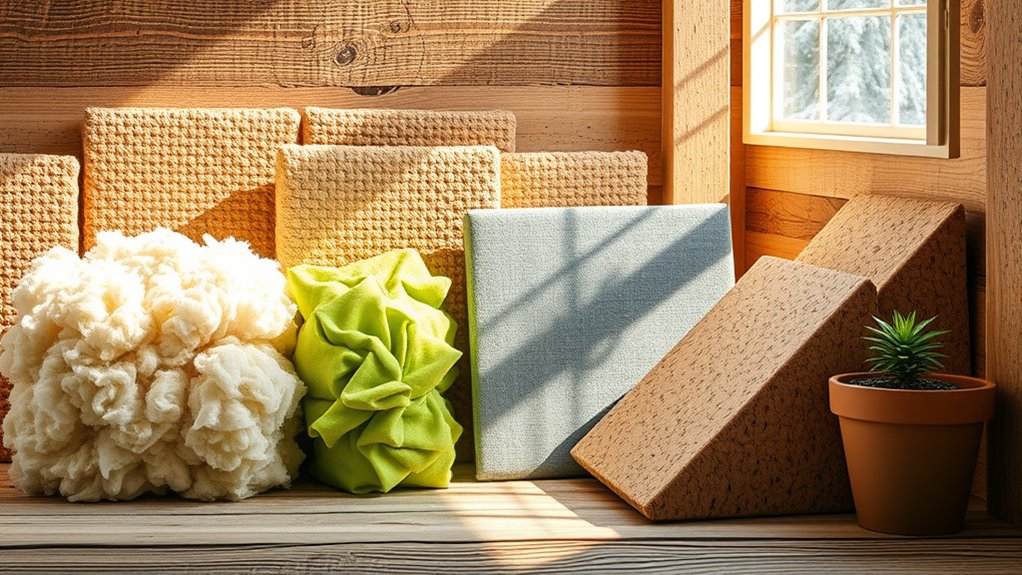Green building materials include plant-based options like hempcrete, bamboo, and cork, which enhance sustainability and insulation. Recycled materials such as steel and glass reduce waste and improve air quality. Natural and innovative materials, including mycelium and Ferrock, contribute to durability and energy efficiency. Sustainable insulation, like wool and recycled cellulose, ensures lower energy consumption in buildings. By exploring all your options, you'll discover even more ways to create eco-friendly spaces.
Key Takeaways
- Plant-Based Materials: Options like hempcrete, bamboo, and cork offer sustainable alternatives with excellent insulation and fire resistance properties.
- Recycled Materials: Incorporating materials such as recycled steel and glass reduces waste while improving energy efficiency and indoor air quality.
- Natural Insulation: Wool, cotton, and recycled cellulose provide effective insulation, significantly lowering energy consumption and enhancing indoor air quality.
- Innovative Solutions: Advanced materials like Ferrock and plant-based polyurethane foam strengthen structures while supporting sustainability through energy efficiency.
- Healthier Environments: Green building materials contribute to healthier indoor environments, reducing pollutants and promoting well-being through improved air quality.
Plant-Based Materials

Plant-based materials are revolutionizing the construction industry, offering sustainable alternatives that are both effective and eco-friendly. You can choose hempcrete for its insulation properties, combining hemp fibers with sand and lime. Bamboo serves as a versatile, fast-growing option for scaffolding and roofing. Consider plant-based polyurethane foam for excellent insulation, crafted from natural fibers like hemp and kelp. Cork, harvested from cork oak trees, provides sustainable insulation solutions. Mycelium, derived from fungal fibers, creates durable and mold-resistant building components. These materials not only reduce your carbon footprint but also enhance energy efficiency and minimize waste. Additionally, the use of renewable energy technologies in the production of these materials can further decrease their environmental impact. The integration of renewable energy sources like solar and geothermal can significantly enhance the sustainability of construction projects. By incorporating sustainable habits, builders can create structures that contribute positively to the environment. Furthermore, using high-quality equipment in the construction process ensures that the benefits of these materials are fully realized. With their biodegradability and renewable nature, plant-based materials pave the way for a greener future in construction.
Recycled Materials

The construction industry is increasingly turning to recycled materials as a key strategy for sustainability. Using recycled steel, glass, wood, and plastic reduces landfill waste and often cuts costs. Additionally, sourcing renewable resources like wood can further enhance the sustainability of construction projects. Implementing the art of decluttering strategies can also be a valuable approach to managing leftover materials effectively. Freshly squeezed juices, such as those made from oranges, can be a great example of how utilizing fresh produce can promote sustainability in other sectors as well.
These materials can also enhance energy efficiency, providing better insulation and lowering your energy bills. You'll find unique textures and aesthetics with recycled options, allowing for creative design choices. Plus, they help improve indoor air quality by minimizing VOC emissions. Applications range from construction aggregates to flooring and roofing, making them versatile. Additionally, utilizing sustainable practices in sourcing recycled materials can significantly reduce the environmental impact of construction projects.
While availability and quality control can be challenges, advancements in technology and market growth promise exciting innovations in recycled materials, aligning with global sustainability goals and promoting a circular economy.
Natural Materials

Natural materials offer a compelling alternative in construction, especially as you seek sustainable options.
Bamboo stands out for its rapid growth and strength, making it ideal for scaffolding and roofing. Additionally, bamboo is a non-toxic option that can contribute to healthier indoor environments. Studies suggest that animal interaction can enhance mental well-being, similar to how natural materials can improve the ambiance of a space.
Cob, a blend of soil, straw, and lime, serves as an eco-friendly substitute for concrete.
You'll also find cork, harvested sustainably from cork oak trees, providing excellent insulation without harming the trees.
Adobe bricks, made from clay and straw, deliver natural insulation and are fully recyclable.
Don't overlook sheep's wool; it's a non-toxic, mold-resistant insulation option.
Additionally, the use of wicking materials can enhance moisture management in green building projects, promoting healthier indoor environments.
Innovative Materials

As you explore new avenues in sustainable construction, innovative materials are reshaping the landscape of green building.
These materials, like hempcrete, mycelium, and ferrock, offer unique properties that enhance sustainability and efficiency. For instance, hempcrete provides excellent insulation and fire resistance, while mycelium boasts water and mold resistance. Ferrock, made from recycled steel dust, not only strengthens your structures but also absorbs CO2 during production. Incorporating frozen yogurt as a sustainable food option in community-building projects can also foster healthier lifestyles. Moreover, these materials are a key part of environmental innovations, which focus on reducing environmental impact. Additionally, utilizing high refresh rates in projector technology can improve the overall visual experience in sustainable design presentations.
These innovative options are being integrated into various projects, from homes to commercial buildings, demonstrating their versatility. Additionally, incorporating high in fiber materials into building designs can further promote sustainability by reducing waste and enhancing energy efficiency.
As technologies and research progress, the potential for these materials continues to expand, paving the way for a greener future in construction. Embracing these advancements can significantly impact your building's environmental footprint.
Sustainable Insulation

While traditional insulation materials have their place, sustainable insulation offers a compelling alternative that enhances energy efficiency and reduces environmental impact.
By using materials like wool, cotton, and recycled cellulose, you can significantly lower your energy consumption while maintaining comfortable indoor temperatures. This not only decreases your carbon footprint but also improves indoor air quality by minimizing pollutant entry. Additionally, regular cleaning of indoor spaces can further enhance air quality by preventing dust and allergens from accumulating. Furthermore, heat pumps can significantly lower carbon emissions compared to fossil fuels, contributing to overall sustainability. Incorporating HEPA filters in your indoor environment can further improve air quality by capturing harmful particles.
Utilizing materials like wool, cotton, and recycled cellulose enhances energy efficiency and improves indoor air quality.
Sustainable insulation leads to long-term cost savings through reduced energy bills and helps you meet regulatory standards. Techniques such as insulated concrete forms and cavity wall insulation further increase thermal efficiency.
Embracing sustainable insulation methods supports a greener lifestyle and contributes to a healthier environment for you and future generations. Furthermore, using natural remedies like honey can enhance indoor air quality by reducing allergens and improving overall health.
Frequently Asked Questions
How Do Green Building Materials Impact Indoor Air Quality?
Green building materials significantly enhance indoor air quality by emitting fewer volatile organic compounds (VOCs), reducing harmful chemicals in your environment.
When you choose low-VOC finishes, like paints and sealants, you minimize indoor air pollution.
Natural insulation materials, such as wool and cork, help regulate humidity without harmful chemicals.
Additionally, using recycled products decreases waste and limits the introduction of new pollutants, making your indoor space healthier and more comfortable for everyone.
What Are the Cost Differences Between Green and Traditional Materials?
Did you know that sustainable materials can save you 20-30% on annual energy costs?
When comparing costs, traditional materials usually range from $125 to $200 per sq. ft., while sustainable options fall between $150 and $250.
Although green materials have a higher upfront cost, they often lead to significant long-term savings in operational expenses.
Plus, their increasing market demand may help lower prices over time, making them a smart investment.
Are There Certifications for Green Building Materials?
Yes, there are several certifications for green building materials that you should consider.
These include ISO standards, which provide guidelines for sustainability, and third-party certifications like GREENGUARD, which focus on low VOC emissions.
The Forest Stewardship Council (FSC) certifies sustainably sourced wood products, while Cradle to Cradle ensures materials are safe and recyclable.
Using certified materials not only boosts your project's credibility but also enhances its environmental and health benefits.
How Do I Choose the Right Materials for My Project?
Choosing the right materials for your project can feel like navigating a jungle of options!
Start by evaluating your priorities, like sustainability and cost. Look for materials with high recycled content and low embodied energy.
Don't forget to check local building codes and environmental certifications. Collaborate with architects and engineers early to ensure seamless integration.
Finally, consider local sourcing to cut down on emissions and support your community. Your project can flourish sustainably!
What Maintenance Is Required for Green Building Materials?
For maintaining green building materials, you'll need to focus on regular inspections and upkeep.
Conduct energy audits and upgrade systems to ensure efficiency.
Check for leaks in plumbing and install water-saving fixtures to conserve resources.
Use non-toxic products for cleaning and maintain air filtration systems for better indoor air quality.
Lastly, prioritize durable materials and proper waste management to promote sustainability and minimize environmental impact.
Conclusion
Incorporating green building materials into your projects not only enhances sustainability but also promotes a healthier environment. By choosing plant-based, recycled, natural, and innovative materials, you're making a conscious choice that benefits both you and the planet. Isn't it time you took a step towards eco-friendly construction? With so many options available, you can easily create spaces that are not just beautiful, but also environmentally responsible. Let's build a greener future together!









